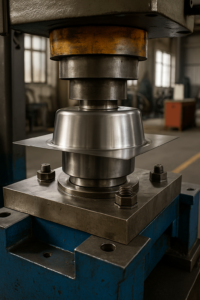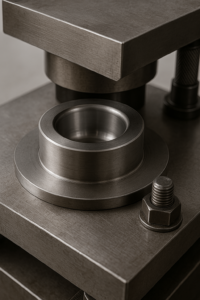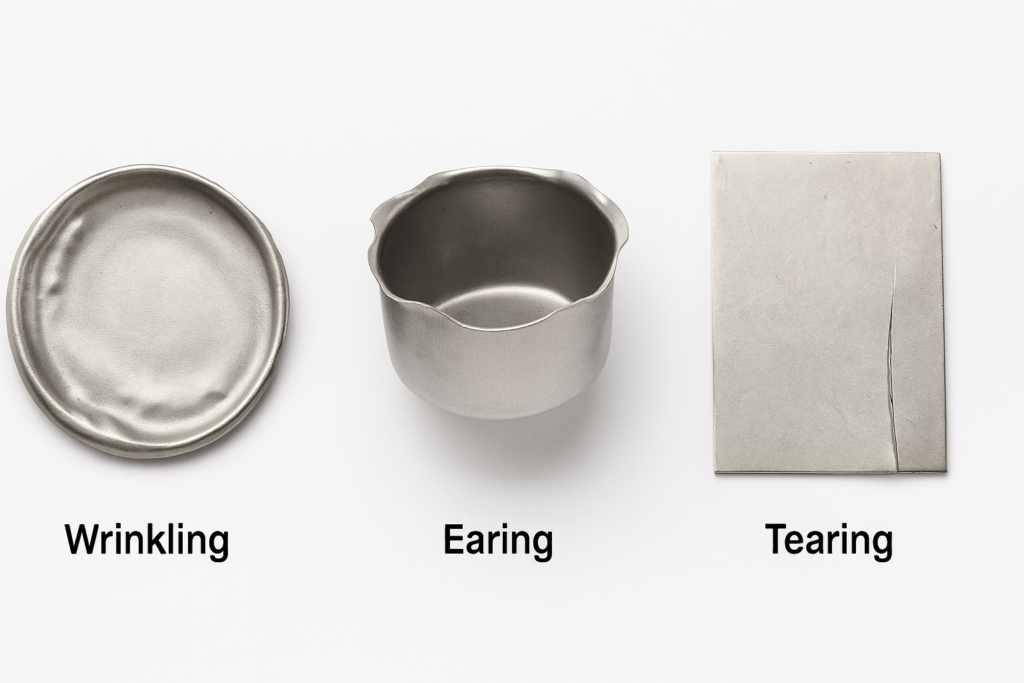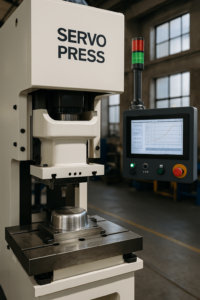Introduction: Engineering for Supply Chain Excellence
In global manufacturing, the reliability of a component is paramount. The seamless form of a stainless steel enclosure or the robust, complex geometry of an automotive housing is not just a matter of design—it’s a testament to a highly controlled and repeatable manufacturing process.
Sheet metal deep drawing is a cornerstone of modern production, transforming flat metal sheets into strong, seamless 3D parts. For OEM procurement managers, B2B buyers, and bulk metal part specifiers, understanding this process is key to vetting a supplier’s production reliability and cost-efficiency.
This blueprint moves beyond basic definitions to provide a strategic framework for what matters most in your supply chain: achieving quality, consistency, and cost-effectiveness at scale, especially when sourcing from a RoHS- and ISO-certified metal fabrication partner.
🔍 Looking for a reliable custom deep drawn parts manufacturer? Need help with OEM deep drawing fabrication services? This guide gives you the technical insight to select the right partner.
1. What is Deep Drawing? A Foundation for Procurement Decisions
At its core, sheet metal deep drawing is a forming process where a flat metal blank is drawn into a die by a punch to create a hollow shape. A part is considered “deep drawn” when its depth exceeds its radius, a feat that requires exceptional process control.
For purchasing teams, the critical distinction lies between deep drawing and other methods like stamping. While stamping is a broad term, deep drawing specifically involves the controlled flow of material, not just stretching it. This distinction is vital because it directly impacts part integrity, production yield, and lifecycle cost.
This method retains the material’s original thickness far better than stretching, resulting in a stronger, more uniform final component. This inherent strength and the creation of seamless parts are key advantages, eliminating potential weak points from welds or joints and ensuring reliability in applications that demand a perfect seal.
2. The Process Visualized: A Journey in Repeatable Quality
Understanding the mechanics of the deep drawing operation reveals a supplier’s commitment to precision and quality control at every stage. The process is a sequence of highly controlled mechanical actions designed for repeatable outcomes in volume runs.
Step 1: The Blank & Placement
The journey begins with a precisely cut sheet metal blank. The quality of this first step is non-negotiable, as it dictates material usage, dimensional repeatability, and yield. The blank is then accurately positioned over the die cavity, the foundation for the part’s external geometry.
Step 2: The Clamp & Control
Next, a blank holder applies a carefully calibrated pressure to the blank’s edges. This is not a simple clamp; it is a critical control point. The blank holder force is engineered to prevent wrinkling while allowing the material to flow smoothly—a delicate balance that separates experienced manufacturers from the rest.
Step 3: The Draw
With the blank secured, the punch descends, pressing the sheet into the die cavity and initiating the plastic deformation. The controlled flow of metal, guided by the tooling and managed by the blank holder, forms the part’s walls. This is where a supplier’s mastery of the physics of metal forming becomes evident.

Step 4: Ejection & Finishing
Once formed, the part is ejected, and any excess material is removed in a trimming process. Depending on the project’s specifications, the component may then proceed to finishing operations—such as deburring, coating, or forming calibration—to meet surface and dimensional tolerances. This end-to-end control ensures the final product meets production quality expectations.
3. Cracking the Material Code: A Strategic Sourcing Decision
Material selection is more than a technical detail; it’s a strategic sourcing choice that impacts unit cost, lifecycle value, and downstream operations. A supplier’s expertise in material science is a direct indicator of their ability to deliver OEM-grade deep drawn components consistently.
The Language of Formability: Properties that Impact Your Product
Two scientific parameters are crucial for predicting performance:
- Strain Hardening (n-value): This measures a material’s ability to strengthen as it’s formed. A high n-value is desirable as it helps distribute stress uniformly, preventing localized thinning that can lead to part failure—a critical factor for ensuring component reliability.
- Anisotropy (r-value): This measures a material’s resistance to thinning. A high r-value is excellent for drawability. However, variations in this property can cause “earing” (a wavy edge), which increases scrap and secondary processing costs. A capable supplier will help select materials that balance these properties for optimal results.
Material Deep Dive: A Comparative Guide for Procurement
Different metals present unique challenges and opportunities, impacting both performance and budget.
- Low-Carbon Steel: As the workhorse for deep drawing steel, it offers an excellent balance of formability and cost-effectiveness, making it ideal for a wide range of automotive, HVAC, and enclosure components.
- Stainless Steel: When corrosion resistance and durability are non-negotiable, deep drawing stainless steel is the premier choice. However, it requires significantly higher forming pressures and specialized lubrication. A supplier’s ability to handle stainless steel is a strong indicator of their technical capabilities.
- Aluminum Alloys: For applications demanding lightweight strength, deep drawing aluminum is unmatched. Managing its tendency for springback requires advanced tooling and process control, another key differentiator for expert manufacturers.
4. The Engineer’s Toolkit: Mastering Variables for Production Reliability
Consistent, high-quality output is not accidental. It is the result of mastering a set of interconnected deep drawing process parameters. This is where a supplier’s process control and tooling know-how truly become a strategic advantage for buyers.
Tooling Geometry: The Foundation of Precision
The design of the punch and die, particularly the radii of their edges, is fundamental to a successful draw. The die entry radius in a deep drawing die design is a make-or-break feature.
An incorrectly sized radius can either restrict material flow, causing tears and costly part failures, or allow uncontrolled flow, leading to wrinkles. At YISHANG, we apply 26+ years of hands-on expertise to engineer tooling with optimized geometry, ensuring smooth material flow and dimensional control from prototype through production.

Blank Holder Force (BHF): The Art of Process Control
The Blank Holder Force (BHF) is the most critical adjustable parameter in the process. It’s a delicate balancing act: too much force restricts material flow and causes fractures; too little allows wrinkling.
An expert manufacturer doesn’t just set it and forget it. Advanced operations utilize a variable BHF, dynamically adjusting the pressure throughout the draw cycle. This sophisticated level of control significantly reduces defect rates and ensures a more stable, reliable production run.
Strategic Lubrication: Mitigating Risk and Ensuring Quality
Friction is the enemy of a flawless finish. A high-quality deep drawing lubricant is essential for creating a protective boundary between the tooling and the workpiece. This prevents galling and scratches that can lead to rejected parts and costly tool wear.
The selection of the right lubricant—from deep drawing oils to advanced synthetic fluids—is a critical decision based on material type and draw depth. This attention to detail is a hallmark of a quality-focused deep drawing manufacturer.
5. The Defect Diagnostic Clinic: A Guide to Risk Mitigation
For a procurement professional, understanding potential defects is crucial for supplier evaluation and quality assurance. A supplier’s ability to predict, prevent, and resolve these issues is a direct measure of their process maturity.

Problem #1: Wrinkling – The “Accordion Effect”
- Business Impact: Wrinkles are not just cosmetic flaws; they are structural defects that can compromise the integrity of the part and trigger automatic rejections in quality inspections.
- Root Cause: This occurs when compressive stresses develop in the flange area due to insufficient blank holder force or poor draw bead design. The metal folds rather than flows.
- Solutions: Corrective actions include increasing the blank holder force, redesigning draw beads to improve material control, or optimizing the die entry radius to reduce resistance.
Problem #2: Tearing / Fracture – The Catastrophic Split
- Business Impact: A tear results in immediate scrap and potential tool damage. In critical applications, it may also create internal risk liability.
- Root Cause: Excessive tensile stress from too much blank holder force, sharp tooling radii, or poor lubrication creates necking and eventual rupture.
- Solutions: Reduce BHF, apply proper lubrication, increase punch/die radii, and verify material ductility meets required strain energy.
Problem #3: Earing – The Wavy Edge
- Business Impact: Ear formation adds trimming operations, which reduces yield and increases tooling wear.
- Root Cause: Caused by planar anisotropy in rolled sheet metal. Different grain orientations resist flow unevenly.
- Solutions: Use materials with lower r-value variation, rotate blank orientation during nesting, or compensate by adjusting initial blank shape using simulation.
Problem #4: Surface Defects – Scratches, Galling, and “Orange Peel”
- Business Impact: Aesthetic issues lead to cosmetic rejections, especially in exposed parts like enclosures or housings.
- Root Cause: Inadequate lubrication, poor surface finish on tooling, or coarse grain structure in material (orange peel).
- Solutions: Use polished dies, implement higher-quality deep drawing lubricant, or source fine-grained, cold-rolled base materials.
Problem #5: Dimensional Defects – Springback and Uneven Thinning
- Business Impact: Tolerance loss during post-form inspection can result in scrapped parts or downstream assembly misalignment.
- Root Cause: High-yield-strength materials store elastic energy that is released after forming, returning the shape slightly.
- Solutions: Use FEA to predict springback and compensate via tool design (overbending, coining), and choose materials with lower yield/tensile ratios.
6. The Future of Forming: Investing in Technology for Quality and Efficiency
A forward-thinking supplier invests in technology that de-risks production and enhances quality. Two key innovations are transforming the deep drawing landscape and strongly indicate a manufacturer’s level of digital maturity and quality investment.
Virtual Prototyping: How FEA Simulation Reduces Lead Times
Finite Element Analysis (FEA) tools like AutoForm or DynaForm allow manufacturers to simulate the deep drawing process digitally. Engineers can analyze the material flow, identify risk zones (e.g., thinning, tearing, wrinkling), and optimize tool geometry before a single die is machined.
This digital prototyping significantly reduces trial-and-error tooling costs and compresses product development timelines. For procurement managers, this means fewer iterations, more predictable lead times, and reduced hidden costs.
The Servo Press Revolution: Unlocking Precision and Repeatability
Servo presses allow for full control over ram motion—speed, dwell time, deceleration—all programmable based on part geometry and material response. Compared to mechanical presses, servo-driven systems provide:
- Optimized stroke profiles for complex materials (UHSS, 5xxx/6xxx aluminum)
- Variable BHF and slide velocity throughout the stroke
- Energy efficiency and longer tool life
This enables forming of difficult geometries with tighter tolerances, critical for battery trays, automotive housings, and stainless appliance parts.

7. Deep Drawing in the Real World: Three Case Studies in Capability
High-Speed Beverage Can (Aluminum)
- Challenge: Ultra-thin aluminum walls drawn at high speed with zero fracture tolerance.
- Solution: Multi-stage draw + ironing process with precise die polishing and micro-lubrication.
- Key Insight: Demonstrates mastery of yield control in fast-cycle operations.
Deep Stainless Steel Sink
- Challenge: Drawing deep bowls without tearing due to stainless steel’s low elongation and work hardening.
- Solution: Multi-pass drawing with intermediate annealing to recover ductility between stages.
- Key Insight: Illustrates deep draw of work-hardening metals with thermal process integration.
Automotive Oil Pan (High-Strength Steel)
- Challenge: Shaping UHSS without tearing, with final product requiring structural strength.
- Solution: Hot forming followed by die quenching to achieve mechanical strength while maintaining shape.
- Key Insight: Integration of thermal forming, timing control, and advanced dies to manage strength and geometry.
8. Pro-Tips for Designers & Engineers: A Guide to Manufacturability (DFM)
Working with your supplier early during part design helps reduce cost, scrap, and delays. Here are principles specifically for deep drawn part optimization:
Corner Radii
Avoid sharp internal corners. A common guideline is to maintain internal punch radii at least 6–10x material thickness, depending on alloy.
Symmetry and Balanced Draw
Asymmetric parts introduce uneven material flow, requiring advanced control or multi-pass drawing. Symmetry improves draw stability.
Limiting Drawing Ratio (LDR)
Stay within the safe draw ratio of the material. For example, most steels have an LDR of 2.0–2.2, while aluminum may be lower.
Surface Finish Considerations
Functional or aesthetic? Smooth finish requires better tool polish and material prep. Communicate finish specs early.
Lubrication Strategy
Plan lubricant selection with the supplier. Chlorinated paraffins for stainless, synthetic esters for aluminum, etc.
Clearance and Tolerancing
Die-punch clearance should be 107–115% of sheet thickness. Too tight = risk of galling; too loose = wrinkling risk.
Trim Allowance and Re-Draw Plans
Always allow extra trim margin on high-draw components, and plan for potential redraws in multi-stage forming.
Conclusion: Your Blueprint for a Reliable Supply Chain
The journey from a flat sheet to a flawless component is a complex interplay of material science, precision engineering, and advanced process control. Mastering deep drawing is about mastering risk, ensuring quality, and delivering consistency at scale.
At YISHANG, we support global B2B buyers and industrial OEMs through our ISO 9001 and RoHS certified metal fabrication processes, advanced deep drawing tooling, and long-term production partnerships. If you are sourcing custom deep drawn

